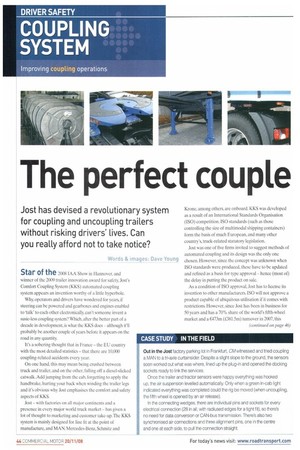The perfect couple
Page 44

Page 46

If you've noticed an error in this article please click here to report it so we can fix it.
Jost has devised a revolutionary system for coupling and uncoupling trailers without risking drivers lives. Can you really afford not to take notice?
Star of the 2008 IAA Show in Hannover, and
winner of the 2009 trailer innovation award for safety. Jost's Comfort Coupling System (KKS) automated coupling system appears an invention worthy of a little hyperbole.
Why, operators and drivers have wondered for years, if steering can be powered and gearboxes and engines enabled to 'talk' to each other electronically, can't someone invent a susie-less coupling system? Which, after the better part of a decade in development, is what the KKS does although it'll probably be another couple of years before it appears on the road in any quantity It's a sobering thought that in France the EU country with the most detailed statistics that there are 10,000 coupling-related accidents every year.
On one hand, this may mean being crushed between truck and trailer, and on the other, falling off a diesel-slicked catwalk. Add jumping from the cab, forgetting to apply the handbrake, hurting your back when winding the trailer legs and it's obvious why Jost emphasises the comfort and safety aspects of KKS.
Jost with factories on all major continents and a presence in every major world truck market has given a lot of thought to marketing and customer take-up. The KKS system is mainly designed for line fit at the point of manufacture, and MAN, Mercedes-Benz, Schmitz and Krone, among others, are onboard. KKS was developed as a result of an International Standards Organisation (ISO) competition. ISO standards (such as those controlling the size of multimodal shipping containers) form the basis of much European, and many other country's, truck-related statutory legislation.
Jost was one of five firms invited to suggest methods of automated coupling and its design was the only one chosen. However, since the concept was unknown when ISO standards were produced, these have to be updated and refined as a basis for type approval hence (most of) the delay in putting the product on sale.
As a condition of ISO approval, Jost has to license its invention to other manufacturers. ISO will not approve a product capable of ubiquitous utilisation if it comes with restrictions. However, since Jost has been in business for 50 years and has a 70% share of the world's fifth-wheel market and a €473m (1381.5m) turnover in 2007, this
shouldn't prove too onerous. It's hoped to have the paperwork cleared by 2010, by when manufacturers could be geared up for factory fit and seed vehicles in fleets for training purposes.
Jost's design ethos was to keep KKS simple, particularly the electronic architecture, because to market the concept it needed the support of truck and trailer builders. Since KKS will be integral to a bigger capital purchase, pricing will he determined by what margin manufacturers add.
Truck buyers are, mainly, conservative and Jost is aware many will take one or two units with KKS to see how it performs operationally before committing to more.
But, some who have spent a long time in the road transport industry might rightly observe, this isn't a new idea. The famous Scamrnell automated coupling of mechanical horse fame in the 1930s or its competitor, the Jen Tug, could both be coupled without the driver leaving the cab. More recently, was a Scania patented design from the 1970s. The key difference is that these were mechanical devices. Jost's KKS is far more sophisticated and engineered — a decade in development — with future-proof capacity to accept new technological innovation, such as braking by wire — within the existing interface.
Life improving?
But does it work? Will a driver's life improve without what Jost refers to as 'helix cable' connecting truck and trailer like an umbilical cord? KKS is already on fleet trials and, as its 'midwife', Jost vice-president Jose Alguera points out, the real test won't be owner-drivers on pan-European trips but supermarket fleets with several trailer drops and pick-ups every shift.
Jost claims KKS has numerous advantages over conventional coupling: speed — typically 2/3 minutes as opposed to 3/8 manually. On some trailer-swop trunk runs and JIT deliveries this could make the difference in completing them in drivers' hours rules. Safety: no squeezing and climbing into tight, dirty gaps — it'll make yard shunters happy and might even help recruitment — no one ever became a driver to wrestle with jammed fifth wheel locks and broken susies. And a reduction in maintenance and damage: no driving off and stretching a forgotten cable to breaking point or dropping the trailer on its nose. There's already some discussion of insurance companies reducing premiums to firms using KKS.
One positive environmental advantage of KKS may be to permit closer coupling, and therefore better aerodynamics and full consumption.
KKS adds up to 5kg to unladen weight but, says Jost, could save up to 50kgs when adapted across a fleet by eliminating catwalks and steps. Both the coupling wedge and electric motors to raise the landing legs increase a trailer's unladen weight and inevitably there's an additional payload penalty for dual-equipped units. As Alguera says: "It's easy for an engineer to make things complex, but simplicity aids robustness and reliability."
This is one of the most radical and exciting innovations we've seen in recent years, something that could achieve one of the biggest operational changes in truck operation. KKS is a triumph of design and engineering, but will the artic market embrace it?




























































































































































